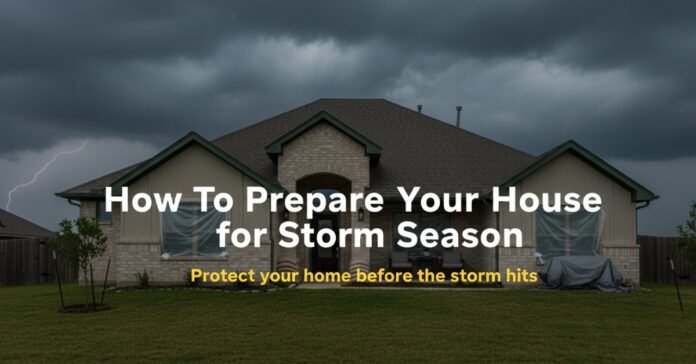Summary: Storm season can bring unpredictable weather, from heavy rain and strong winds to flash floods. Preparing your home in advance can help prevent costly damage and keep your family safe. This guide covers practical storm-preparation tips — including roof inspections, gutter cleaning, flood protection, and safety planning — to help you stay protected all season long.
Why Storm Preparation Matters?
Every year, storms cause millions of dollars in property damage. Roof leaks, power outages, and water intrusion are common problems homeowners face during extreme weather. Proper preparation ensures your home can withstand severe conditions and minimizes potential losses.
A well-maintained home not only improves safety but can also reduce insurance claims and enhance property value.
1. Inspect and Reinforce Your Roof
Your roof is the first line of defense against storms. Before storm season hits, schedule a professional roof inspection to identify weak spots, missing shingles, or leaks. Even minor roof issues can lead to significant water damage during heavy rain or high winds.
Roofing Tips:
-
Replace damaged or missing shingles immediately.
-
Seal cracks and flashing around chimneys or vents.
-
Trim overhanging tree branches near the roof.
-
Consider hiring a professional for a complete inspection.
If you’re located in Texas, make sure to contact the best roof inspection contractor in Webster, Texas to ensure your roof is strong enough to withstand the storm season. Their experienced team can help with roof repairs, replacements, and inspections to keep your home safe.
2. Clean Gutters and Downspouts
Clogged gutters can cause rainwater to overflow, leading to roof leaks, foundation damage, and flooding. Clean out leaves, dirt, and debris from your gutters and downspouts regularly.
Gutter Maintenance Checklist:
-
Remove debris using a trowel or hose.
-
Ensure downspouts direct water away from the foundation.
-
Install gutter guards to prevent future clogs.
-
Check for leaks or sagging sections.
Proper drainage plays a huge role in protecting your home’s structure during storms. Regular maintenance ensures that water flows freely away from your property.
3. Secure Windows and Doors
High winds can cause windows and doors to rattle or even break. Protect your home by reinforcing these entry points.
Tips for Window & Door Protection:
-
Install storm shutters or impact-resistant glass.
-
Apply weatherstripping around doors and windows to prevent leaks.
-
Reinforce garage doors with bracing kits.
Don’t forget to close and lock all openings before the storm hits—this simple step can prevent extensive interior damage and maintain your home’s safety.
4. Check Your Yard and Outdoor Areas
Objects left in your yard can become dangerous projectiles during a storm. Taking time to secure outdoor items is an essential part of storm preparation.
What To Do:
-
Store patio furniture, umbrellas, and grills in a shed or garage.
-
Anchor large outdoor equipment.
-
Trim trees and shrubs to remove weak or dead branches.
-
Inspect fences and gates for stability.
A well-maintained yard not only looks tidy but also reduces the risk of property damage during high winds or heavy rainfall.
5. Protect Against Flooding
Flooding is one of the most common types of storm damage. Even if you don’t live in a flood-prone area, heavy rains can overwhelm drainage systems.
Flood-Prevention Tips:
-
Elevate electrical appliances and outlets if you live in a low area.
-
Use sandbags or flood barriers around entry points.
-
Check sump pumps and backup generators.
-
Seal basement cracks and apply waterproof coatings to walls.
If you notice poor drainage around your home, contact a professional to inspect your grading or install a reliable gutter system to prevent water accumulation.
6. Create an Emergency Plan
Preparation isn’t just about your property—it’s about your family’s safety. Having an emergency plan ensures everyone knows what to do if a severe storm strikes.
Key Steps:
-
Keep emergency supplies (first-aid kit, flashlights, batteries, food, and water).
-
Save important documents in a waterproof container.
-
Charge all mobile devices before the storm.
-
Establish a safe room or designated shelter area.
-
Discuss evacuation routes and local emergency contacts with your family.
Being prepared can make a huge difference in stressful situations and helps you respond calmly during emergencies.
7. Review Your Home Insurance
Check your homeowner’s insurance policy to understand what’s covered in case of storm damage. Many policies don’t automatically cover flooding or wind damage, so it’s wise to review your plan before storm season starts.
What To Look For:
-
Coverage for roof and water damage.
-
Deductibles and limits for storm-related claims.
-
Additional coverage options for floods or windstorms.
-
Contact details for quick claim reporting.
Being proactive with insurance ensures financial peace of mind after the storm passes.
Stay Safe and Storm-Ready
Preparing your house for storm season might seem overwhelming, but taking these preventive steps can save you from costly repairs and ensure your family’s safety. Start early—inspect your roof, secure your property, and have a solid emergency plan ready.
A well-prepared home is your strongest defense against the unexpected. If you’re unsure where to start, consider booking a professional home inspection and roof maintenance service from the best roofing contractor in Webster, Texas before the next storm hits. Stay safe, stay prepared, and protect your home year-round.

